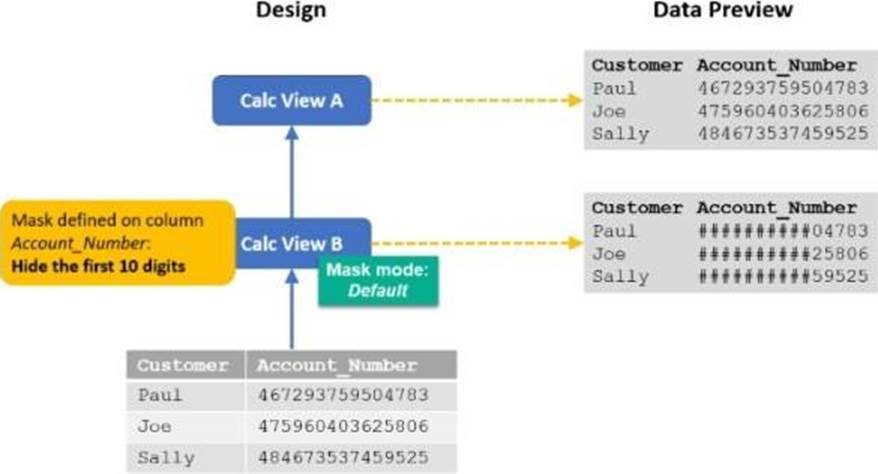SAP C_HCMOD_03 SAP Certified Application Associate – SAP HANA Cloud Modeling Online Training
SAP C_HCMOD_03 Online Training
The questions for C_HCMOD_03 were last updated at Jan 04,2026.
- Exam Code: C_HCMOD_03
- Exam Name: SAP Certified Application Associate - SAP HANA Cloud Modeling
- Certification Provider: SAP
- Latest update: Jan 04,2026
A new version of SAP HANA Cloud, SAP HANA database is available from today.
If you do not perform the upgrade manually, how much time do you have before your database will be automatically upgraded to the next version?
- A . 7 months
- B . 3 months
- C . 2 weeks
- D . 1 year
Why would you use parameter mapping in a calculation view? Note: There are 2 correct answers to this question.
- A . To pass variable values to external value help views
- B . To assign variables to one or more attributes
- C . To push down filters to the lowest level calculation views
- D . To convert the data types of input parameters
You are deploying a new calculation view, A, that uses calculation view B, as shown in the diagram.

When you preview calculation view A, the account number is not masked.
What could be the reason?
- A . You previewed the data with the technical user in SAP Business Application Studio.
- B . You did not define masking in calculation view A.
- C . The UNMASKED privilege has NOT been granted at the schema level.
- D . The type of the Account_Number column is VARCHAR.
In Business Application Studio, you rename a DIMENSION calculation view that is used by a CUBE calculation view. You do NOT use the option to rename the runtime view and adjust the reference. Afterward, you perform the following deploy operations: Deploy the DIMENSION calculation view as a single object. Deploy the entire SAP HANA database module.
What is the outcome of the deploy operations?
- A . The first deployment is successful. The second deployment fails.
- B . The first deployment is successful. The second deployment is successful.
- C . The first deployment fails. The second deployment fails.
- D . The first deployment fails. The second deployment is successful.
In a calculation view, your table function node executes a table function that requires input parameters.
How can you fill the input parameters of the table function? Note: There are 3 correct answers to this question.
- A . Define constant values.
- B . Assign a hierarchy node.
- C . Reference the output of a procedure.
- D . Map columns from lower nodes.
- E . Create and map an input parameter
Why do you use the Hidden Columns checkbox in the semantics node of your calculation view? Note: There are 2 correct answers to this question.
- A . To prevent passing columns in stacked calculation views
- B . To ensure specific columns are NOT exposed to the reporting tool
- C . To remove a column that is also used as a Label column
- D . To avoid exposing sensitive columns when defining calculated columns
You have defined a pruning configuration table in a calculation view.
What are you attempting to prune from the query execution?
- A . Calculated columns
- B . Filters
- C . Joins
- D . Data sources of unions
In a database module, what is the purpose of the .hdiconfig file?
- A . To specify an external schema in which calculation views will get their data
- B . To specify which HDI plug-ins are available
- C . To specify in which space the container should be deployed
- D . To specify the namespace rules applicable to the name of database objects
You deleted the design-time file of a calculation view in your HDB module.
What is the recommended way to ensure that the corresponding runtime object is also removed from the database?
- A . Deploy the folder that contained the deleted design-time file.
- B . Execute a DROP statement in an SQL Console connected to the HDI container.
- C . Deploy the project that contained the deleted design-time file.
- D . Execute the refactor function for the calculation view.
You define a hierarchy in a calculation view. You want to expose the hierarchy to SQL.
Which of the following conditions must be met? Note: There are 2 correct answers to this question.
- A . The hierarchy must be exposed by a calculation view of type CUBE with star join.
- B . The hierarchy must be a shared hierarchy.
- C . The hierarchy must be a local hierarchy.
- D . The hierarchy must be a parent-child hierarchy.
Latest C_HCMOD_03 Dumps Valid Version with 80 Q&As
Latest And Valid Q&A | Instant Download | Once Fail, Full Refund

